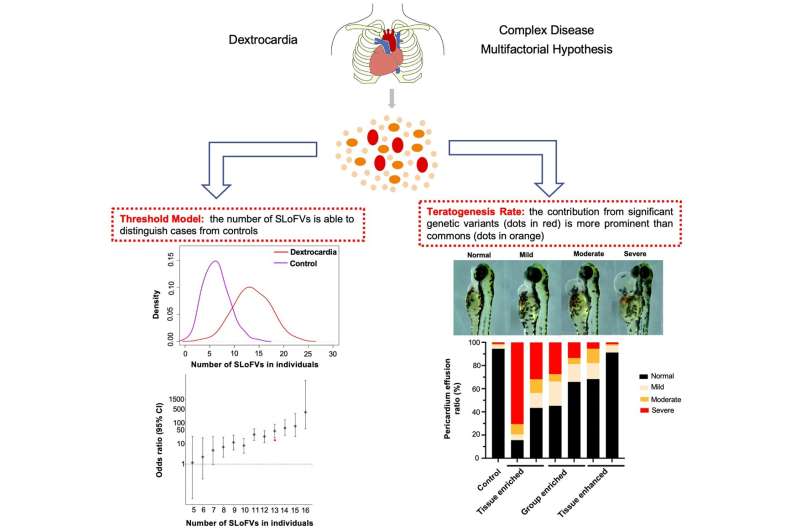This article has been reviewed according to Science X's editorial process and policies. Editors have highlighted the following attributes while ensuring the content's credibility:
fact-checked
trusted source
proofread
Rare loss-of-function variants reveal threshold and multifactorial inheritance of dextrocardia

Dextrocardia, a condition where the heart is located on the right side of the thoracic cavity, occurs in approximately 0.83 of 10,000 pregnancies and is often associated with complex congenital heart diseases (CHDs).
Complex CHDs refers to a group of CHDs that are more severe and require more complex surgical procedures to correct compared to other types of CHDs. Clinically, CHD is thought to be a type of ciliopathy. However, the genetic patterns underlying dextrocardia, whether they are driven by cilia-related genes, and whether the applicability of the "omnigenic" threshold to explain such complex traits remain unclear.
This study was led by Prof. Hongyan Wang (Institute of Reproduction and Development, Obstetrics and Gynecology Hospital, Institute of Metabolism and Integrative Biology, Fudan University), Prof. Qihua Fu (Shanghai Children's Medical Center, School of medicine, Shanghai Jiao Tong University), Prof. Haifa Hong (Shanghai Children's Medical Center, School of medicine, Shanghai Jiao Tong University), and Prof. Jianguo Zhang (BGI Genomics).
First, Chen et al. identified that 44% of dextrocardia patients carried loss-of-function (LoF) variants in well-established candidate ciliopathy-associated genes, indicating the pathogenic roles of ciliary genes in dextrocardia. Although the occurrence of dextrocardia with complex CHD is associated with both the asymmetrical development of the left-right axis and the development of the heart itself, no significant excess of rare LoF variants identified in the ciliary gene set, heart-specific gene set or TGF-beta signaling gene set.
Subsequently, they demonstrated that dextrocardia shares an omnigenic genetic architecture. They revealed that a threshold number of singleton loss-of-function variants (SLoFVs) for dextrocardia risk. When the number of SLoFVs reached 8, the OR for dextrocardia was greater than 1 [OR = 6.9 (1.2–21.2)]. As the number of SLoFVs increases, the risk for dextrocardia increases exponentially, with an OR of 22.8 (11.4–44.7) for 12, OR = 59.6 (25.3–151.2) for 14, and OR = 357.8 (56.9–13429.0) for 16 SLoFVs.
By further exploring the various weighted genes on cardiac malformation, they found that the heart-tissue/group-enriched expressed genes knockdown produced significantly higher rates of heart abnormalities and played more direct roles than broadly expressed enhanced genes knockdown in zebrafish, which confirm the biologically interpretable roles of genes specifically expressed in heart cells conferred by the omnigenic model.
This team demonstrates that the existence of a genome-wide genetic risk threshold for dextrocardia based on SLoFVs and confirmed the differential effects of various weighted genes on cardiac malformation. This study enriches our understanding of the genetic effects of core genes under the whole-genome model, providing a new theoretical basis for comprehending the genetic pathogenesis of complex diseases like dextrocardia.
The work is published in the journal Science Bulletin.
More information: Zhongzhong Chen et al, Rare loss-of-function variants reveal threshold and multifactorial inheritance of dextrocardia, Science Bulletin (2023). DOI: 10.1016/j.scib.2023.08.005





















